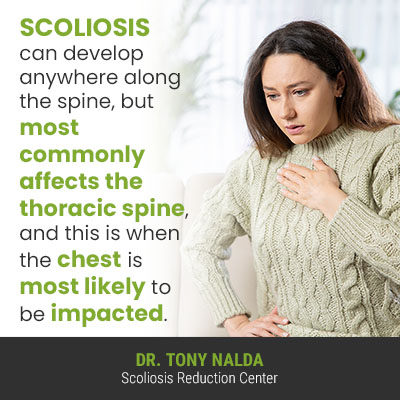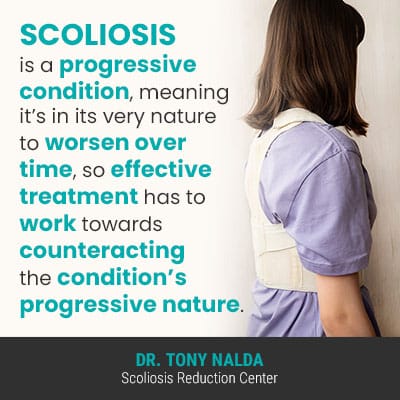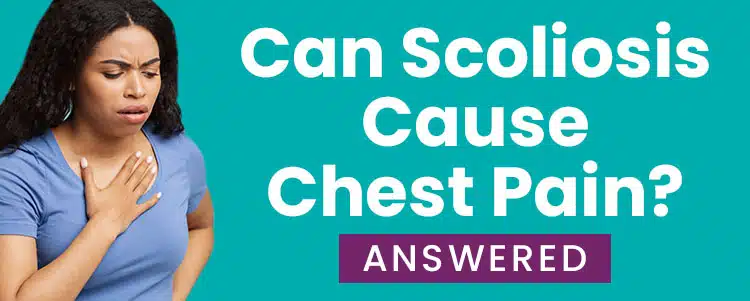Scoliosis introduces a lot of uneven forces to the body and can affect it in a myriad of ways; however, there is no one-size-fits-all description of life with the condition. Important patient/condition variables such as patient age, curvature location, condition severity, and causation help shape the way scoliosis affects the body.
Scoliosis is an unnatural sideways spinal curve with rotation, and can affect any spinal section. When it affects the thoracic spine, it can also affect a patient’s chest. In severe forms, chest pain and lung impairment can become an issue, particularly if left untreated.
To start our discussion on scoliosis and chest pain, let’s touch on some basic spinal anatomy for a clearer understanding of how scoliosis affects spinal health and function.
Basic Spinal Anatomy
Everyone’s spine is curved; the natural and healthy spinal curves make it stronger, more flexible, and better able to absorb/distribute mechanical stress during movement.
There are a number of spinal conditions that involve a loss of the spine’s healthy curves and making them under or over-pronounced. When the spine loses one or more of its healthy curves, it disrupts its overall function, biomechanics, and health.
Scoliosis is a structural spinal condition that involves the development of an unnatural sideways curve, with rotation, meaning the spine doesn’t just bend unnaturally to the side, it also twists from back to front, front to back, making scoliosis a 3-dimensional condition.
If the unnatural spinal curve has rotation and measures more than 10 degrees, this is diagnosed as scoliosis and what’s known as Cobb angle determines how severe a condition is:
- Mild scoliosis: Cobb angle measurement of between 10 and 25 degrees
- Moderate scoliosis: Cobb angle measurement of between 25 and 40 degrees
- Severe scoliosis: Cobb angle measurement of 40+ degrees
- Very-severe scoliosis: Cobb angle measurement of 80+ degrees
As you can see from the wide range of Cobb angle measurements, scoliosis is a highly-variable condition, so what one patient might experience is not necessarily indicative of what others will.
As mentioned, condition severity is an important factor when it comes to the type of symptoms patients are likely to experience, as is curvature location and causation.
There are three main spinal sections: cervical (neck), thoracic (middle/upper back), and lumbar (lower back).

Scoliosis can develop anywhere along the spine, but most commonly affects the thoracic spine, and this is when the chest is most likely to be impacted.
While scoliosis can cause chest pain; scoliosis can also lead to pain along with other issues such as radiculopathy, urinary problems, and a host of other scoliosis-related conditions.
Common Scoliosis Symptoms
As mentioned earlier, scoliosis introduces a lot of uneven forces to the body, and as the spine works in tandem with the brain to form the body’s central nervous system, the spine is involved in practically every working system within the body, which is why spinal conditions can cause such a wide range of symptoms.
The main visual way that scoliosis affects the body is by disrupting its natural symmetry; the condition’s earliest symptoms and telltale signs in adolescents can include:
- Uneven shoulders
- One shoulder blade protruding more on one side than the other
- The development of a rib arch
- Uneven hips
- Uneven waistline
- Arms and legs that appear to hang at different lengths
As scoliosis disrupts the body’s natural symmetry, clothing can become ill-fitting, and changes to gait, balance, and coordination can also occur.
It should be mentioned that while adolescent idiopathic scoliosis (AIS), diagnosed between the ages of 10 and 18, is the condition’s most prevalent form, it also affects adults, and the most common symptom of scoliosis in adults is pain.
Scoliosis doesn’t become compressive until skeletal maturity has been reached, which is why children and adolescents don’t commonly find the condition painful; the lengthening motion of a growing spine can counteract the compressive force of the unnatural spinal curve.
When it comes to rib pain, this is most commonly associated with thoracic scoliosis and how it impacts the chest, and the thoracic spine is the spinal section most commonly affected by scoliosis.
Chest pain can be a frequent concern among individuals with scoliosis, but it’s essential to understand the relationship between scoliosis classification, hereditary factors, and common myths to address this issue accurately.
Rotoscoliosis, particularly when severe, may result in chest pain, potentially due to the compression of adjacent structures caused by the rotational curvature of the spine.
Chest pain is not commonly associated with scoliosis; however, in cases of cervical scoliosis, moderate scoliosis, or when scoliosis leads to the development of a Dowager’s hump, there may be an indirect impact on chest discomfort due to the alteration of spinal alignment and its effect on the surrounding structures.
Scoliosis Rib Pain
As mentioned, the thoracic spine refers to the middle and upper back, and if scoliosis develops in the upper thoracic spine, it can cause postural deviation in the form of a rib arch.
A rib arch can develop because as scoliosis is a 3-dimensional condition (rotational component), as the spine twists, so does the chest, which can lead to the development of a rib arch as the ribs on one side of the back start to protrude more when bending.
In most cases, noticeable rib pain is more common in adults, in severe forms, particularly if left untreated or not treated proactively.
If left untreated, severe scoliosis can progress, and related postural deviation can also increase, including rib arches, and as this happens, the body can become more affected, particularly in terms of lung impairment.
To be clear, when it comes to scoliosis and lung impairment, this isn’t a common symptom and, as mentioned, is more clearly associated with severe forms; when it does occur, it can be due to how the condition affects the chest.
As a rib arch increases in size, it leaves less space for the lungs to fully inflate, but in many cases, scoliosis-related lung impairment is only detected in those who place higher-than-average demands on their respiratory systems, such as professional athletes. The average person is unlikely to notice a decrease in lung space due to a scoliotic rib arch.
Levoconvex scoliosis is a spinal condition that can sometimes lead to chest pain, as the abnormal curvature of the spine may put pressure on the chest area and affect the surrounding structures.
In addition, chest pains and muscle spasms can also be a part of postural deviation that affects the chest, but, again, it is not a common symptom and is more associated with severe forms.
Individuals with neuromuscular scoliosis may experience discomfort or complications related to their condition that could lead to chest pain.
So as I keep saying that certain symptoms are more likely to develop if scoliosis is left untreated, let’s move on to how to prevent increasing condition severity and escalating symptoms, such as chest pain and lung impairment, with proactive treatment.
Scoliosis Treatment Options
When it comes to addressing any and all scoliosis-related symptoms, the key is being proactive with treatment.

Scoliosis is a progressive condition, meaning it’s in its very nature to worsen over time, so effective treatment has to work towards counteracting the condition’s progressive nature.
While there are two main scoliosis treatment approaches to choose between, traditional and conservative, the former doesn’t value proactive treatment, involves a lot of watching and waiting, and tends to funnel patients towards spinal fusion surgery. The latter is a modern approach that values applying proactive treatment as close to the time of diagnosis as possible.
Here at the Scoliosis Reduction Center®, I combine multiple condition-specific treatment disciplines delivered through a conservative treatment approach that, first and foremost, works towards impacting conditions on a structural level, in the form of a curvature reduction.
Through a series of chiropractic adjustments and various techniques, when successful, I can modify the position of affected vertebrae by realigning the spine.
When combined with in-office therapy, custom-prescribed home exercises, scoliosis exercises and corrective bracing, I can combine structural results with increasing core strength, so the spine is optimally supported and stabilized by its surrounding muscles.
By impacting the condition on a structural level, related issues of postural deviation, including a rib arch, are addressed as the unnatural spinal curve is reduced and the spine’s healthy curves are restored.
Scoliosis, when left untreated, can sometimes lead to complications such as chest pain and even arthritis in some cases.
Conclusion
So can scoliosis cause chest pain: yes, it can, but it isn’t a common symptom and is more related to severe forms or conditions that are left untreated.
Conditions that are left untreated, or aren’t treated proactively, are allowed to progress unimpeded, and this is wasting valuable treatment time.
Even sleeping with scoliosis and finding the best sleeping position can sometimes exacerbate discomfort when scoliosis causes muscular imbalance, but maintaining a positive mental attitude can help alleviate associated challenges, including managing chest pain.
While there are never treatment guarantees, it’s at its easiest to treat when a condition is caught early and responded to proactively. The curve is at its smallest, significant progression hasn’t occurred yet, and the body hasn’t yet had time to adjust to the unnatural curve’s presence, so there are fewer limits to what we can achieve.
When it comes to chest pain and scoliosis, we’re talking about the uneven forces the condition introduces, the unnaturally-curved spine pulling on the rib cage, causing a disruption to its positioning that can lead to the development of a rib arch.
In addition, chest pain can also be related to sore and tight core muscles that become unbalanced and strained as they struggle to support an unnaturally-curved spine.
Here at the Scoliosis Reduction Center®, patients experiencing chest pain, or any other symptoms related to scoliosis, can work towards improvements on multiple levels, and the Center’s results speak for themselves, so don’t hesitate to reach out for support or guidance.





